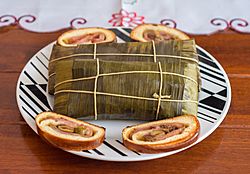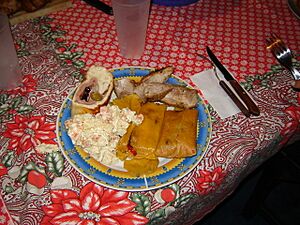Hallaca facts for kids

Hallaca and Pan de jamón
|
|
| Alternative names | Ayaca, Hayaca, Guanimo, Tamal, Pasteles en Hojas |
|---|---|
| Type | Dumpling |
| Region or state | Latin America |
| Main ingredients | cornmeal dough or cassava dough, meat (beef, pork, chicken), raisins, capers, olives |
| Variations | Pasteles, Guanime, Alcapurrias |
Hallaca is a special dish from Venezuela, a bit like a tamale. It's made with a soft cornmeal dough, filled with a yummy stew of beef, pork, or chicken. You'll also find tasty things like raisins, capers, and olives inside.
This delicious mix is wrapped in plantain leaves, tied up, and then boiled. Hallacas are a big part of Christmas celebrations in Venezuela, and different regions have their own special ways of making them. Many people see hallaca as a national dish of Venezuela. You can also find similar dishes in places like eastern Cuba, Trinidad, Colombia, Ecuador, Aruba, and Curaçao.
Contents
The History of Hallaca
Hallaca is a dish that came from the Mesoamerican region, where similar tamal-like foods were common. After the Spanish arrived, these dishes spread across the Americas.
How Hallaca Was Invented
People believe that hallaca was first created by enslaved people during the time of Spanish rule. They would prepare big Christmas Eve meals for the landowners. With the leftover meat, they would make a special filling for their own Christmas meal, which became the hallaca.
One story says that the daughter of a landowning family tried the hallacas and loved them. She and her family enjoyed the dish so much that they asked for it to be made for their own dinner parties. Since then, hallaca has become a traditional holiday meal for everyone, no matter their background.
What's in a Name?
The word hallaca has an interesting history. According to Adolfo Ernst, a scholar, the word likely comes from the indigenous Guaraní language. It might have come from the verb ayua or ayuar, which means "to mix or blend." So, ayuaca meant "mixed things," and over time, it changed to ayaca and then hayaca or hallaca.
Another idea is that the word comes from an old language in western Venezuela, meaning "wrapping" or "bundle." The first time the word hallaca was used in its modern sense was in a document from 1781 by an Italian linguist named Filippo Salvatore Gilii.
How Hallacas Are Made
Making hallacas is a detailed process, and the ingredients can change from one region or family to another.
The Flavorful Filling
The filling for hallacas is usually more complex than a standard tamale. It often includes a mix of beef, pork, bacon, onion, sweet pepper, garlic, salt, pepper, oregano, cumin, and some cooking wine or vinegar. In the Venezuelan Andes region, the meat filling is often not pre-cooked. Some recipes also add leeks, Worcestershire sauce, or brown sugar. The stew is cooked slowly for several hours to get all the flavors just right.
Regional Variations
In Aruba and Curaçao, islands near Venezuela, the dish is called 'ayaca' or 'ayaka'. Their version often has pork and chicken stew, capers, raisins, cashews, bell peppers, and olives. The dough is made from white cornmeal, and the plantain leaves are greased with lard or oil. After wrapping, they are boiled for about two hours.
In Puerto Rican cuisine, a similar dish called hayaca used to be very popular. Unlike the Venezuelan hallaca, the Puerto Rican hayaca is made with cassava dough, not corn. It's also baked in a traditional wood-fired oven. The filling usually has diced pork butt cooked with sofrito, annatto oil, olives, capers, chickpeas, and raisins. Because it takes a lot of time and skill to prepare, hayaca is not as common today, but you can still find it in some family-owned restaurants.
Preparing the Dough and Wrapping
The corn dough for hallacas is similar to the dough used for arepas. Pork fat is melted with annatto to give the dough a nice golden color. Corn flour is mixed with broth and soft butter, then the cooled pork fat is added to make a soft, golden dough.
A large plantain leaf is greased with vegetable oil, and the dough is flattened on it. Then, the guiso filling is placed on top, along with other ingredients like onion, pepper, parsley, potatoes, raisins, almonds, chickpeas, capers, green olives, hard-boiled eggs, and bacon. The leaf is then tied up and the hallaca is boiled at a low heat. Hallacas can even be made ahead of time and frozen for later!
Holiday Traditions

Hallaca is a key part of Christmas celebrations in Venezuela. A traditional Venezuelan Christmas meal often includes hallacas, pastries, pan de jamón (ham bread), and chicken stew.
Families usually gather in the morning to prepare all the ingredients together. The banana leaves, which come from the fields, need to be cleaned very carefully before they can be used for wrapping. This tradition brings families closer during the holiday season.
In Ecuador, hallacas are popular all year round, not just at Christmas. They have many different versions across the country's regions and are a staple of traditional Ecuadorian food, along with humitas.
See also
 In Spanish: Hallaca para niños
In Spanish: Hallaca para niños


